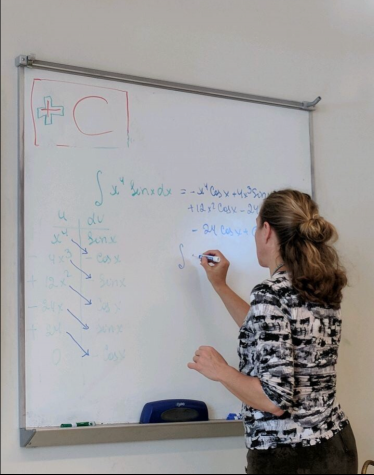Math Department
Photo courtesy of Foster Cowan.
A BC Calculus student working hard on his homework.
January 13, 2020
AP Calculus AB
AB Calculus is often regarded as one of the hardest classes at Chamblee, and certainly is not one for the faint of heart. Taught by Larisa Tulchinsky, AB Calculus is sure to be a challenge no matter how good you have been at math in previous years. AB refers to which concepts are taught; College Board splits calculus into AB and BC, so by taking the AB portion, you are spreading this out across two semesters.
Students have outlined a typical week as extensive, rigorous practice one day followed by difficult assessments the next. The general consensus seems to be that quizzes are the most difficult, followed by tests and homework checks, which are still very challenging but less so than the quizzes.
As for the workload at home, do not take this class if you are not willing to put in the necessary amount of work, which most students say averages about one to two hours of homework nightly. Senior Maddy Trinh sheds some light on the topic of homework.
“There’s a whole plan for the entire year of homework before you get into the class so you can kind of see that, it’s on her website. Every single night there’s homework, so it’s up to you to complete it. She doesn’t really check homework, [but] problems from the homework will appear on homework checks,” said Trinh.
In addition, do not go into the class expecting to get an A. Grades are difficult to maintain, and many students have this class as their first experience with truly struggling to keep a certain grade.
“If you have an A then you are a god,” said senior Logan Durisch. “The assessments in the class are all free response, so if you’re not prepared to demonstrate your knowledge of a subject in the way she wants you to demonstrate it, you’re gonna have problems.”
Tulchinsky is well known for her policy of dropping many of the lowest grades in the gradebook at the end of the semester to help students’ grades, but even with this in place, students still struggle to end with an A or a B.
For those considering taking AB calculus, the general advice is to know what you want to study in college and assess if the course will really be worthwhile.
“If you’re planning on going into something in college that requires math you should probably take AB [calculus],” said Durisch. “I have a cousin enrolled at [the University of Georgia] right now who elected to just take normal calculus [in high school] and as such has to take calculus at UGA, and it being a completely different environment from anything he’s experienced before, he’s having a pretty difficult time. Taking AB calculus in high school allows you to get that college credit under your belt in an environment that it familiar to you before going to ridiculus 120 person lectures at an institution.”
In addition to what you want in the future, it’s also important to consider what the other classes in your schedule will be before taking AB calculus.
“Junior year was the worst year of my life, the worst combination of classes,” said senior Candace Kang, who took AB calculus as a junior. “Because I had AP US History, AP Chemistry and AB calculus all in the same year, I thought I was dying.”
Overall, if you decide that AB calculus is something that fits with your schedule and will benefit you in the future, students describe it as ultimately rewarding, and almost everyone who takes the AP exam gets a 5, the highest score possible.
“I don’t regret taking the class, but if I could go back and change my decision I would because I just don’t need it for what I want to do,” said senior Brenna Turner, who took AB calculus last year. “It was way too much stress and work for not much reward. I did feel a sense of accomplishment at the end, and I got a lot out of it, but what it took from me was more than what I got.”
AP Calculus BC
If you make it through the difficulties of AB calculus, many students find themselves at the natural next step in the math pathway, BC calculus. College Board splits calculus into AB and BC portions, and unlike AB, which spreads AB calculus out across two semesters, BC requires learning both the AB information first semester as well as BC information second semester, making it much more fast paced than the already fast paced AB calculus class.
Just like AB calculus, BC is taught by Larisa Tulchinsky, and thus the routine of the class looks very similar to that described in AB calculus: learning a concept, practicing extensively, taking a test on it, and repeating. Although homework is not for a grade, most students say it is extremely beneficial to do it in order to increase understanding and prepare for assessments.
Just like with AB, BC calculus quizzes are the hardest grades, followed by slightly less challenging tests and homework checks. The policy of dropping the lowest grades from the grade book still applies for this course, but students still struggle to keep their grade up, as the assessments are so difficult.
“It’s not the greatest class to take if you just want to keep an A or have all A’s,” said senior Amy Lin. “You have to go in not knowing if you’re going to get an A or not. You’ll likely [pass] because she drops grades, but it’s hard.”
The majority of students in BC calculus are seniors who have taken AB calculus the year before, but a few junior students often elect to skip AB and go straight to BC, which almost everyone advises against.
“It moves really quickly and it’s definitely good to take AB before taking it,” said Lin. “There’s a lot of juniors who didn’t take AB and went straight to BC and it’s harder for them because we’re moving so quickly. Even for me it’s fast and I did take AB last year.”
If you put in the tough amount of work throughout the year, you are almost assured a 5 on the AP exam according to students.
“[During] second semester, you do a full on practice exam and you go over concepts you’ve learned before so you don’t have to self study for the exam at all outside of class, you’ll just prepare in class,” said senior Layla Dhabaan.
Just like AB calculus, the reward for completing such a rigorous course is high, but not everyone has what it takes to survive until the end. The general advice for BC calculus seems to be take AB first, do your homework, and don’t always expect success.
AP Statistics
Statistics show that nearly all students who take AP Statistics at Chamblee love the class. Taught by Larisa Tulchinsky, the AP Statistics class is almost entirely comprised of sophomores, with a few juniors and seniors in the mix as well. In the class, students learn everything about the subject of statistics, from surveying to graphing to calculating, and most say that the curriculum is more enjoyable than the typical math class.
The routine of the class is very similar to that of AB and BC calculus, learning a concept and doing rigorous practice on it, but much slower paced.
“[Tulchinsky] introduces a new concept for one day and then you’ll probably be working on that concept for the entire week because there are fewer concepts in statistics than calculus,” said junior Victor Lim.
Statistics is very distinct compared to other math courses because there’s a lot of writing and graph analysis involved.
“I don’t think you have to be good at math to do statistics, since a lot of it is calculator work and graph interpretation,” said senior Amy Lin.
Since many students take AP Statistics as sophomores, it is generally agreed upon that the first few months of class hit you hard, since it is many students’ first experience with a very difficult class.
“Statistics was really hard in the beginning of the year, because it’s different than other math [in that] it has a lot of writing involved, so you have to learn how to answer the questions,” said senior Oliver Hurst, who took AP Statistics as a sophomore. “By November my workload dropped a lot because I was able to do the problems faster.”
Homework is necessary to do well in the class, and it often takes multiple hours to complete, which is hard for many students who have never had a class like that before. One part of the class that seems to be universally dreaded is the “Concepts and Terminology” packet, where students have to define vocabulary words for the upcoming unit before they are quizzed on it.
Although it is an adjustment to get used to such a workload, students say that AP Statistics is excellent preparation for AP Calculus, since the teacher is the same, and you can get used to a heavy workload while the subject area is slightly easier.
“I think it’s good as a gateway to higher level math because it’s less difficult and there’s a lot of [memorization] and writing,” said Lin. “If you have those phrases memorized then you’ll get the points. It’s not as much numbers and difficult math, but it’s still the workload of a [Tulchinsky] class.”
Students also used AP Statistics as a way to acclimate to failure.
“If you take statistics, you’re going to fail in some way. The first quiz I took I got a very low grade on, but there’s always and upward trend,” said senior Layla Dhabaan. “Ms. Tulchinsky will always be there to help you, there’s tutorial every day, and although it’s a hard class, it’s really rewarding.”
Since it is generally a sophomore class, the skills gained in AP Statistics can be used in difficult junior and senior classes or even on the SAT.
“If you’re not much of a math person and you still need a math credit to take, you could take statistics,” said Dhabaan. “With chemistry, physics, psychology even, it helps when you’re taking data and analyzing graphs.”
Beyond just other Chamblee classes, statistics has been praised as one of the few high school classes that really feels like it prepares for the real world.
“Statistics can be put into application a lot more ways than calculus,” said Hurst. “Any person that does research, whether you do science or humanities research, you have to know how to do statistics. It’s a really important class that’s a lot more useful later and life and more useful for a broader number of people. It’s a different type of math.”
Most students advise to take it as a sophomore, as it would be a bad idea to take the class in conjunction with a calculus class, which most people do in junior or senior year. The general consensus is that although it is unrelenting in the beginning, AP Statistics ends up not only being a math class that many are very passionate about, but also an excellent preparation for other classes at Chamblee and beyond. As Amy Lin says, “everyone who takes stat loves stat.”
AP Multivariable Calculus
If you are one of the few who has what it takes to advance beyond the regular math pathway, you may find yourself at AP Multivariable Calculus. That being said, it is certainly a niche class; this year only three students are enrolled. Because of the very small numbers, these students sit in on an AB or BC calculus class and do their own work.
“We sit in the back of the room and do independent study, which means we’re supposed to be reading the textbook and doing the homework problems,” said junior Catherine Cossaboom, one of the only AP Multivariable students this year.
If you are in Multivariable Calculus, a level of math far more advanced than most students will ever have to take, it is expected that you are close to being a math genius, which is why the class is reliant on self-discipline and teaching yourself. Tests and quizzes are minimal, and if you work enough in class the workload at home is relatively light. Still, you wouldn’t be in this class if it weren’t for your math prowess, so really be sure that you’re the next Isaac Newton before you enter AP Multivariable Calculus.
This is one of the first years in awhile where an exclusively multivariable calculus class has existed. In years prior, the class has been BC/Multi, where students are taught BC Calculus first semester and then Multivariable Calculus second semester. This year, however, students had to choose between taking BC only or Multi only, and since you need to already know BC Calculus as a prerequisite to multivariable, only a select few ended up taking this course.
Because of the self-taught nature of the class, Multivariable Calculus is certainly more laid back than AB or BC Calculus, which are some of Chamblee’s hardest classes. That isn’t to say that Multivariable Calculus is easy as pi(e), but when you’re in the back of a room with two other students and a textbook, the environment is bound to be a bit more laid back than your average high level math class.
Since homework and stress are comparatively low, it seems that if you have to brain power to even comprehend Multivariable Calculus, which most do not, then it is worthwhile.
“I would recommend this class to people who’ve taken BC because it’s so chill. A lot of people in BC right now are talking about dual enrollment because they don’t want to take Multivariable here, but I’m honestly so glad I didn’t dual enroll this year,” said Cossaboom.

Calculus
For those daunted by the thought of an AP math class (myself included), there’s another option: calculus. Described by students as a laid back class, calculus is a place to learn higher level math in a chill environment well suited for seniors and other upperclassmen. This year, the class is taught by both Amina Fatima and Irvin Wardlow, and although they have radically different teaching styles, the routine and environment of both classes seem to be similar. Students from both teachers describe a typical day as warm up problems, group practice, and then independent study.
The homework load in this class is relatively light, especially when compared with the AP alternative.
“The workload is as much as you want it to be because he [Wardlow] gives you the option to do the homework or not,” said senior Caroline Freshwater. “If you’re really naturally talented at math, you don’t have to do homework but it’s obviously better to practice if you want to have a good grade.”
Senior India Hetherington seconds Freshwater’s claim, but since she has Fatima rather than Wardlow, she says that she is often given the time to finish her homework in class.
“If you get a worksheet, she [Fatima] will most likely let you do it during class so that you don’t have to take it home,” said Hetherington. “If you focus at the beginning of class and get your work done, it will be smooth sailing.”
Both classes seem to be very collaborative, with students using their independent study time to work together on their math problems.
“It’s a good class environment,” said Freshwater. “It’s all upperclassmen, so we’re normally really chill, and there isn’t pressure to sit there quietly. We all work collaboratively.”
Assessments in calculus can sometimes prove difficult, but because of the grades from classwork and warm ups, it is not exceedingly difficult to maintain a good overall class average.
For those considering AP Calculus, nearly all students warn that you really need to assess your abilities and your wants.
“I was in a [Tulchinsky] class for about a week and I decided that because of what I want to study later in life, and because of the other classes I was taking, math was not going to be a priority, and so I decided to switch to this class because it’s less stressful,” said senior Kathryn Penn. “Between my other AP classes and college applications and everything I do extracurricularly, I needed this for myself.”
Everyone who was interviewed enthusiastically seconded Penn’s point.
“If you are taking other APs and you know that math is not you thing or you don’t need that additional stress, I highly recommend [calculus],” said Hetherington. “I decided to take five APs senior year, and couple that with college applications, I would have had way more breakdowns if I had to worry about AP Calculus too.”
With its relatively light workload and relaxed classroom setting, calculus is pretty much universally agreed upon as an excellent option for seniors who have made it to the upper levels of the math pathway, but don’t feel the need to put unnecessary stress on themselves during their final year of highschool.











